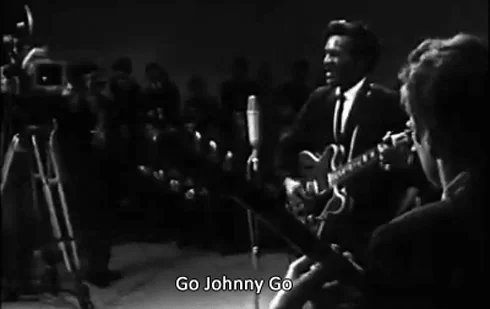“Johnny B. Goode” by Chuck Berry
One of the most important rock and roll songs ever from a true guitar hero.
It's the end of the week, and I want to send everyone off into the weekend with the best vibes possible. That’s why the Daily Music Picks newsletter features a weekly segment called Fun Song Fridays! Regardless of era, genre, or style, the criterion is simple: it must deliver the joy and excitement we all need in our lives.
You can access the entire Fun Song Fridays archive here. While you’re at it, add the companion playlist to your favorite streaming platform.
Today’s music pick is a true rock and roll original from one of the genre’s first publicly anointed guitar heroes.
Genre: Rock, R&B
Label: Chess
Release Date: March 31, 1958
Vibe: 🎸
👉 Click the GIF to stream the album on your favorite platform 👈
I’m not sure there’s another song that defines the essence of rock and roll quite like Chuck Berry’s “Johnny B. Goode.” You have other famous songs about rock and roll, including well-known jukebox staples from Bob Seger and the Rolling Stones, but they don’t encapsulate the genre’s star-making swagger element in the same way. Maybe that’s because there’s a noticeable lack of gimmickry going on. There’s no overproduction or cheap, cloying songwriting tricks. Instead, you have a country boy making good on his potential because, like the protagonist in the song, he can play a guitar “just like ringing a bell.”
Born in St. Louis in 1926, Berry had the misfit reputation that served as the foundation for many rock music mythology. Despite showing promise as a musician at an early age, he was convicted of armed robbery and car theft as a teenager. By the time he was in his early 20s, he’d already been in and out of a correctional facility, started a family, and, to support the latter, was forced to take odd jobs as a factory worker and janitor. It wasn’t until 1955 that Berry would sign with Chess, the label would help him cross over onto the pop charts with songs like “Maybellene,” “Roll Over Beethoven,” and “Rock and Roll Music.” Along with acts like Little Richard, Jerry Lee Lewis, and Elvis Presley, he is one of rock’s true pioneers.
The backstory adds charm and depth to “Johnny B. Goode,” a song that may or may not actually be autobiographical. Berry could read and write and wasn’t a country kid from the South—he was a city dweller in what was then one of the biggest metropolitan centers in the United States. But, in the spirit of the self-consciousness felt in that first verse, he never graduated high school. That period of his life was more or less when music became his entire ambition or at least the strongest one outside of getting into trouble. Despite those biographical contradictions, the character Berry creates is so lovable that you end up rooting for him. You want him to see his name up in lights, just like his mother predicts towards the song's end.
Add one of the most legendary guitar parts ever committed to tape to that narrative, and you’ve got one of, if not the most vital early contribution to rock’s sonic tapestry. Years later, when Bob Zemeckis and Michael J. Fox made “Johnny B. Goode” the focal point of the high school dance in Back to the Future, it was the obvious answer to a seemingly difficult question: how do you sum up the feeling of an entire genre in one recording?
There’s no other song I’d put on that list.




He was unquestionably one of rock's greatest songwriters. No good band in the genre should never be unfamiliar with his vast catalogue of marvels.
Great post.
It's the national.anthem of RnR....it should be played at the end of every live show, by everyone.